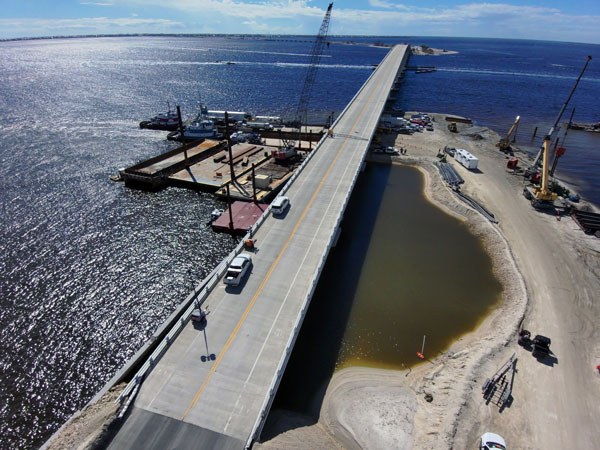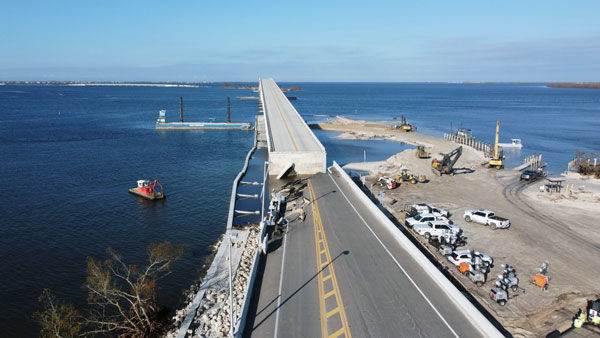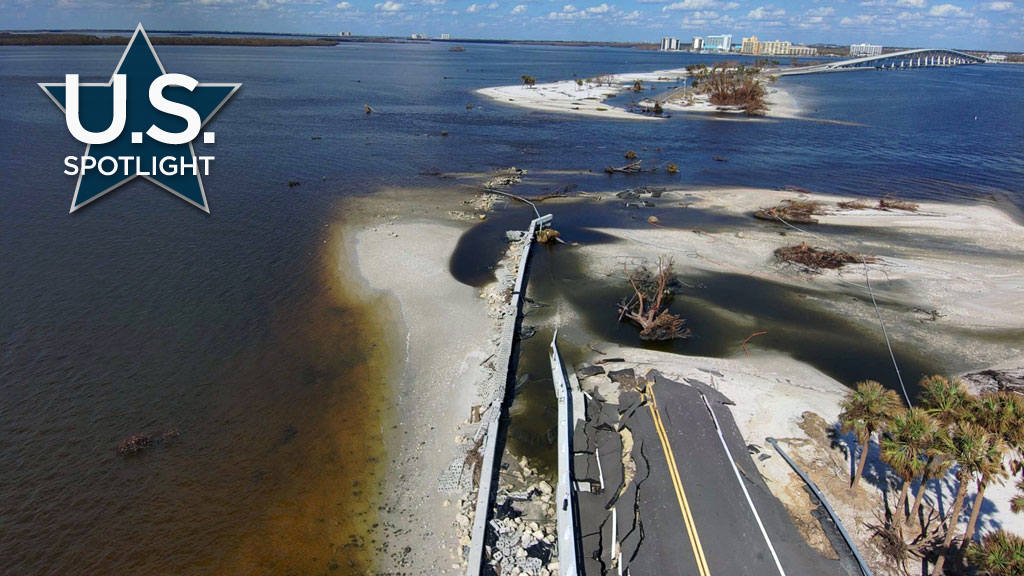On Sept. 28, Hurricane Ian slammed into the west coast of Florida, washing away at least five sections of the three-mile-long causeway that links Sanibel Island to the Florida mainland southwest of Fort Meyers.
The mainland approach to the causeway and sections of the link were partially destroyed by the Category 4 storm, stranding residents on Sanibel and Captiva Islands and hampering recovery efforts. Some thought it would take years while others thought it would take months to temporarily repair the structure.
However, just three weeks later on Oct. 19, Florida Gov. Ron DeSantis, local officials and construction personnel, held a press conference at the entrance to the thoroughfare and announced that emergency repairs had been completed in 15 days. The work was done more than two weeks ahead of schedule.
“Today, I am happy to report that starting at 11 a.m. the causeway will be reopened for the citizens of Lee County,” De Santis declared. “The work that has been done to restore vehicle access to Sanibel Island has been historic.
“Cutting through bureaucratic red tape and delivering on our promise to get Sanibel Island up and running has been a top priority. By restoring access over the causeway, repair crews, first responders, emergency vehicles, business owners and residents will be better able to expedite recovery from this storm.”

Minutes later, a convoy of pickup trucks, followed by a flatbed with heavy equipment, led the way across the causeway.
“When you have real significant damage like that, you can’t let it toil for months without attention,” DeSantis said. “We needed to get it back as soon as possible.”
The task was daunting. Aerial photos showed complete destruction to parts of the causeway. At the bridge approach from the mainland, the road was washed away. In other sections, the structure had collapsed and the pavement crumbled. In one section, the entire road had completely disappeared into the water.
Thanks to the quick work of construction and paving crews, though, the bridge was opened a lot sooner than anyone imagined.
“I am grateful for our dedicated team members who quite literally built a road in the Gulf in 15 days,” explained Florida Department of Transportation (FDOT) secretary Jared Perdue. “While the bridges were largely undamaged by the storm, portions of the causeway which connect bridge structures together were washed away by Hurricane Ian, leaving the bridges unconnected to the mainland or the island.
“A project like this, under normal circumstances, could take months. However, FDOT, along with our law enforcement partners at the Florida Highway Patrol, Lee County and Florida Department of Emergency Management made use of strategic and innovative techniques to rebuild the causeways quickly.”
Crews that worked on the project were amazing and put their hearts and souls into the work, Perdue said.

“People on this project truly worked together day in and day out and had many sleepless nights. What many thought would take six months, the governor pushed us to do it faster and we delivered.”
A small army of workers moved in shortly after the hurricane and began the task of repairing the causeway.
One hundred crews worked about the clock to repair the structure. Dive teams with underwater survey equipment were called in to assess damage to the structure. Seventy pieces of heavy equipment were operating daily, along with four barges, seven cranes, two dredges, five boats and dump trucks.
The crews used 8,200 loads of dirt, 2,400 loads of rock, and 4,000 tons of asphalt to make emergency repairs.
Crews from Jacksonville-based Superior Construction, a joint venture of the de Moya Group, and Fort Myers-based Ajax Paving were contracted to do the work by the FDOT, along with Vulcan Materials. Crews logged more than 36,000 hours on the project.
On Oct. 4, DeSantis had announced repairs to the causeway were being prioritized with an estimated completion date by the end of the month. Just seven days later, the governor announced that due to steady progress on repairs to the causeway, a one-time convoy of more than 350 vehicles for utility restoration safely crossed the bridge onto Sanibel Island.
Damage from Hurricane Ian had prevented emergency vehicles from being able to cross the bridge, delaying the delivery of needed services and supplies to the hard-hit Sanibel community of 6,000 residents.
FDOT will now work with Lee County on plans for permanent repairs to the causeway.











Recent Comments